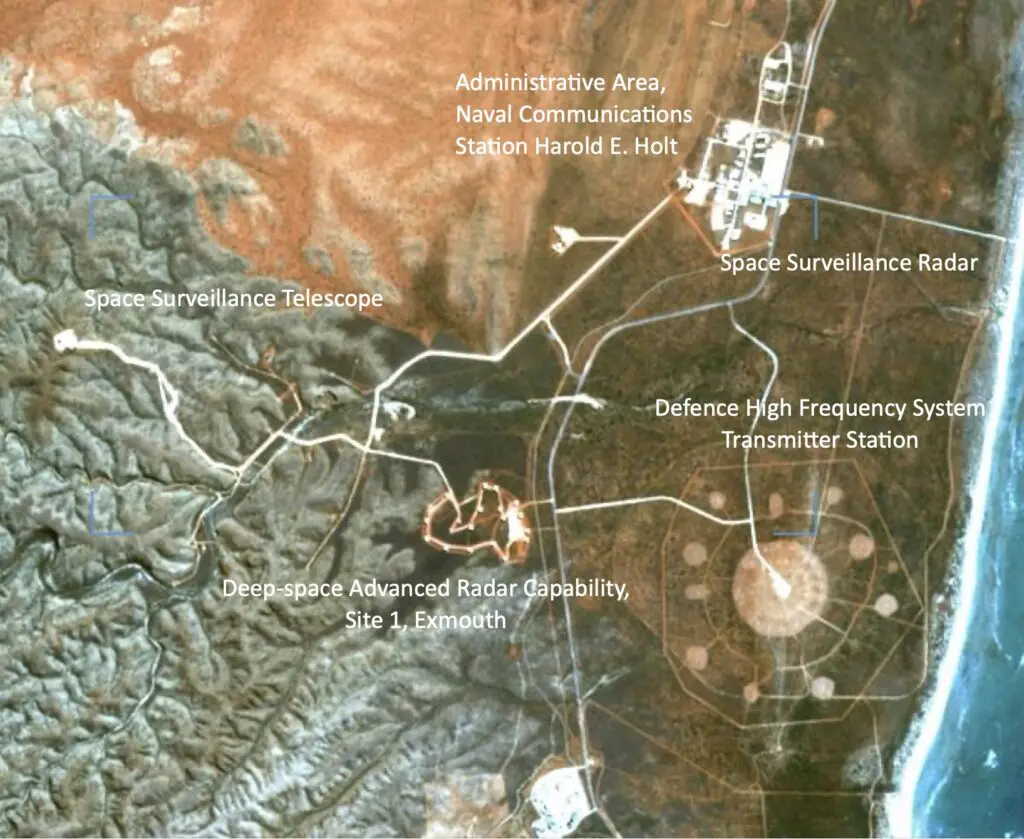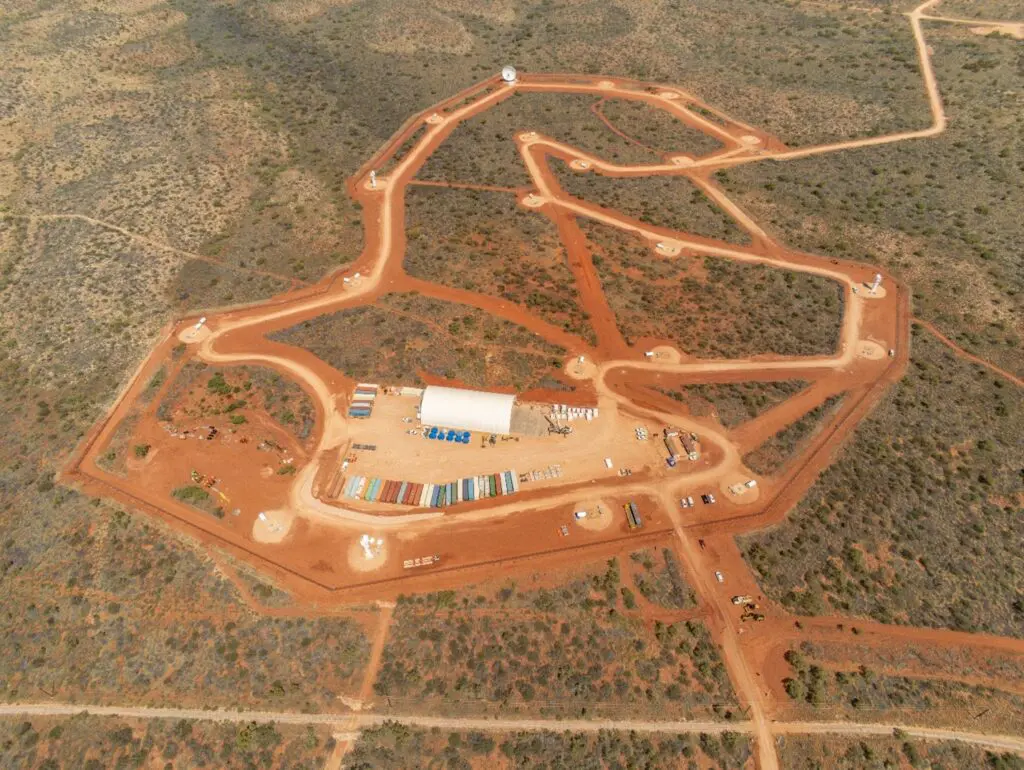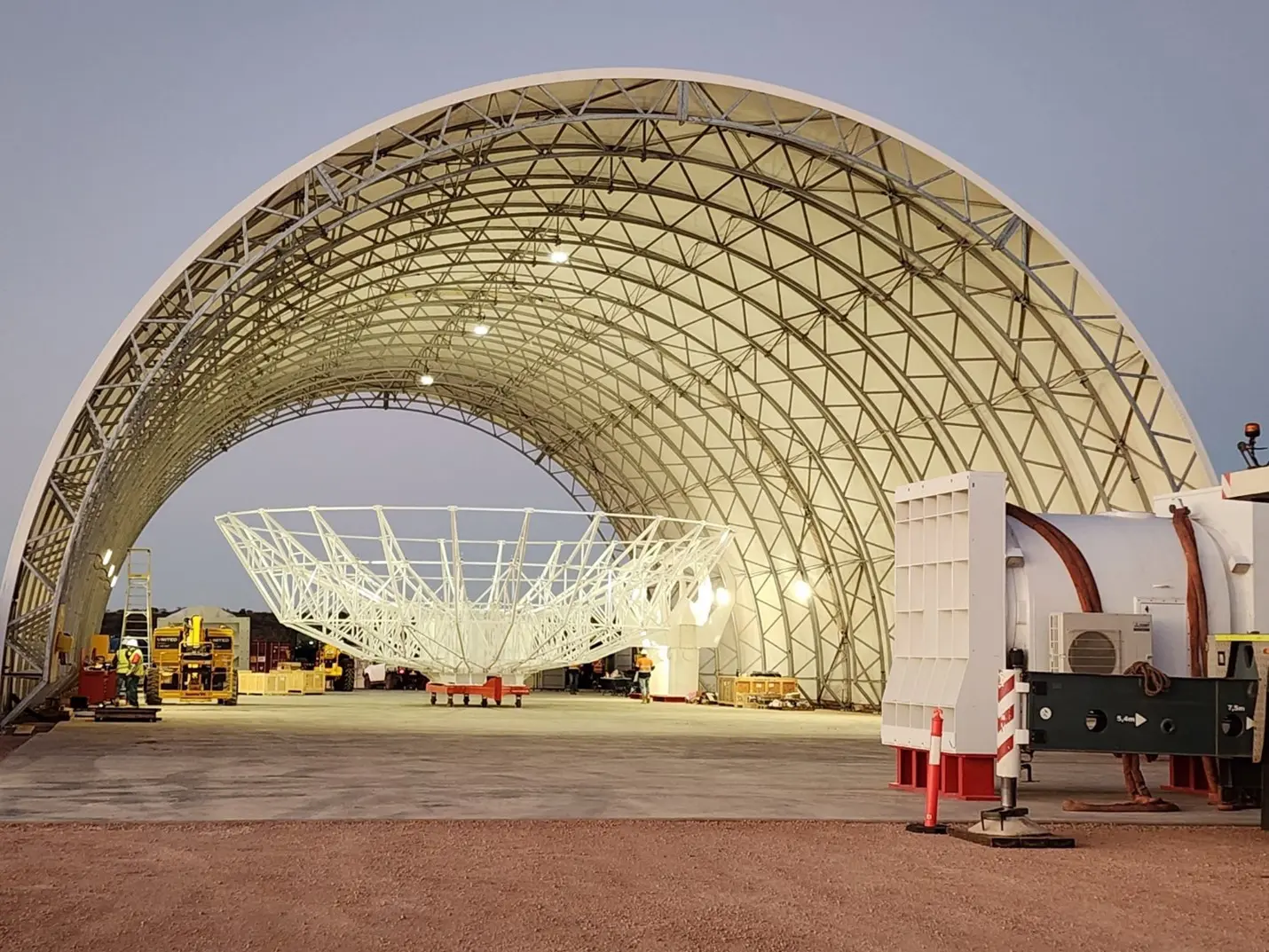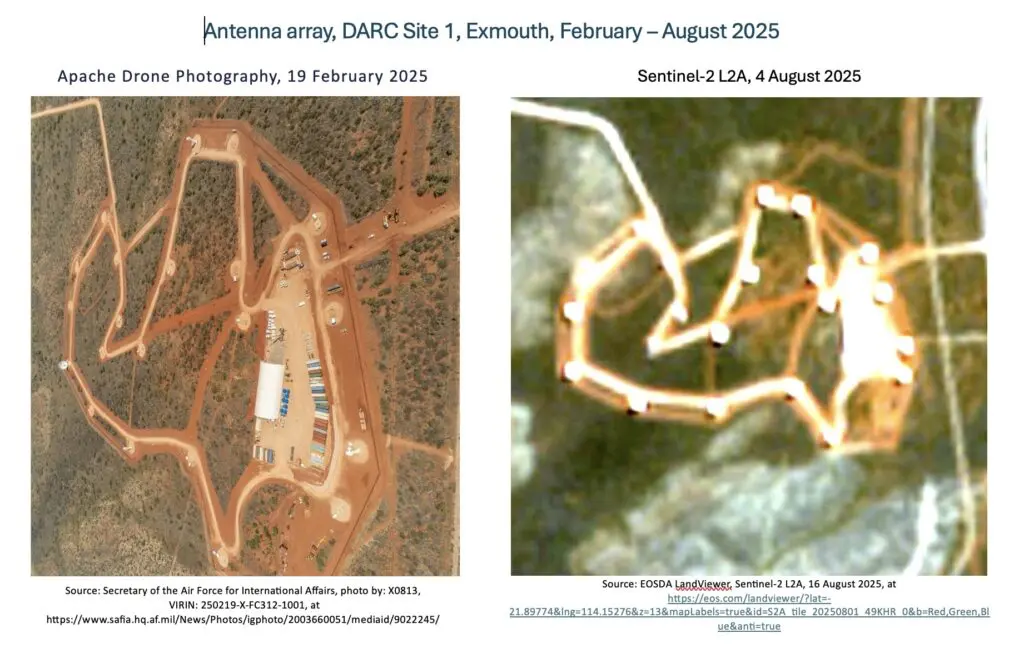Updated 18 August 2025
See also:
- Deep-Space Advanced Radar Capability [DARC]
- Deep-Space Advanced Radar Capability, Site 2, Cawdor Barracks, St Davids, Wales
In February 2022 Northrop Grumman was awarded a US$341 million contract as prime integrator to develop, test and deliver the first DARC site in Australia. In August 2025 Space Systems Command and Northrop Grumman announced a successful linkage of multiple ground-based antennas at DARC Site 1. In addition to the US$341 million award to Northrop Grumman for Site 1, according to the ABC, the Australian government will reportedly spend ‘almost $2 billion over more than 20 years to operate and sustain the WA site’.
Location: -21.905231°, 114.114462°

DARC Site 1 and surrounding facilities. Source: EOSDA LandViewer, Sentinel-2 L2A, 16 August 2025
DARC Site 1 is located on the northern part of the Exmouth Peninsula in Western Australia, between the small town of Exmouth to the south and the huge Very Low Frequency antenna towers of the Naval Communications Station Harold E. Holt on the northern tip of the peninsula, North West Cape. The DARC facility sits in a cluster of major electronic military facilities that personify the contemporary level of integration between Australia and United States defence facilities and operations. The DARPA-designed US-built Space Surveillance Telescope is a few kilometers to the northwest of the DARC array. To the east next to the waters of the Exmouth Gulf is the transmitter station for the ADF’s Enhanced Defence High Frequency System Exmouth facility in a circular array half a kilometer in diameter. A few kilometers northeast of DARC the US-built Space Surveillance Telescope is located on the southeast corner of the administrative area of the Naval Communications Station.

Distributed antennas of the receive array of the Deep-Space Advanced Radar Capability, Site 1, Exmouth under construction. Source: Photo Credit: Apache Drone Photography. United States Space Force, photo by X0813, VIRIN:250219-X-FC312-1001, https://www.spaceforce.mil/Multimedia/Photos/igphoto/2003649357/mediaid/8939687/
Site 1 will host 27 parabolic dish antennas – a small number for transmission, and the remainder tasked with reception. During the August 2025 test, SSC and Northrop Grumman reported that DARC

A reflector being assembled in the Antenna Integration Structure (AIS) at DARC Site 1 in Australia.
photo credit: Mike Kortum, Four Sea Group Inc. United States Space Force photo by X0813, VIRIN: 250219-X-FC312-1002.
According to Northrop Grumman, seven of Site 1’s antennas were able to “characterize the movement of multiple satellites” in recent trials. “DARC’s calibrated antenna arrays operated as a single system to successfully characterize the movement of multiple satellites and demonstrate the effectiveness of the system’s precision radar tracking technology,” said Kevin Giammo, director of space surveillance and environmental intelligence at Northrop Grumman.
Construction of Site 1 began in October 2023. When complete, Site 1 will host 27 parabolic dish antennas. Working together, these smaller radar arrays can combine their signals to act like a much larger, more expensive single-dish system. Full operation is expected in 2027.
The rapid development of Site 1 has been a priority U.S. for both Space Command and IndoPacific Command. In April 2023, the head of Space Forces Indo-Pacific, Brigadier General Anthony Mastalir, said that getting DARC Site 1 operational was ‘absolutely critical’:
‘When you look at a place like Australia as a landmass, you have a lot of opportunity to contribute to that space picture…The Australians, the defense Space Command folks and the acquisition arms, they absolutely understand that, so they’re moving aggressively to embrace some of these opportunities and bring systems like DARC — deep space radar capability — here on the continent.’
GlobalSecurity.org provided an outline of requirements of the Site 1 specified in the 2022 construction contract:
‘FY 2023 plans continue Site 1 design and development activities including design reviews, hardware purchases, software development and integration, and construction. Complete Site 1 EA. Complete final Facility Design Review (90%) and Critical Design Review. Purchase, install and check out hardware including, but not limited to, the antennas, transmitters, receiver hardware, and associated processing, cabling, communications subsystems. Begin construction of Site 1 including roads, buildings, utilities, foundations, and installation of all antenna structures. Perform additional site development efforts such as the construction of facility-support and site infrastructure to include backup generator buildings, fuel storage (tank farms), electrical substations for power site distribution, wastewater treatment/septic & leach, non-potable water storage / fire protection distribution (site & buildings), water treatment (potable) and physical security equipment to meet protection level 3 (PL3) requirements.’
For the Australian Defence Force, DARC Exmouth is an element in Operation Dyurra, described as
‘the dedicated Australian Defence Force space operation which integrates space capabilities, services and effects into wider operations.’
The DARC Exmouth facility will be operated remotely by U.S. and Australian defence forces. As of August 2025, no details have been released about ADF operational involvement with DARC 1, but it is likely that the ADF’s Defence Space Command No. 1 Space Surveillance Unit (1SSU) based at RAAF Base Edinburgh in South Australia will be involved.
No. 1 Space Surveillance Unit operates Australia’s space domain capabilities, including the Space Surveillance Telescope (SST) and Space Surveillance Radar (SSR) located close to the DARC site near Exmouth. No. 1 Space Surveillance Unit also operates the ADF Jindalee Operational Radar Network (JORN), and the Australian Mission Processor that provides Australian access to data downlinked from U.S. infrared Defense Satellite Program and Space Based Infra Red System satellites through the Relay Ground Station at the Joint Defence Facility Pine Gap.
At Edinburgh, No. 1 Space Surveillance Unit operates the SST and SSR together with Operating Location Bravo, an element of U.S. Space Force’s Space Delta 2.
Coordinator: Richard Tanter (rtanter@nautilus.org)


